Prof. Dr. Eline Le Breton
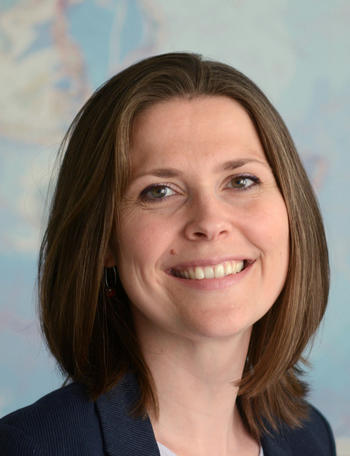
Department of Earth Sciences
Institute of Geological Sciences
Tectonics and Sedimentary Systems
Assistant Professor
Room B 138
12249 Berlin
April 2018 - Junior Professor for Tectonophysics at the Freie Universität Berlin
Oct. 2012 - Apr. 2018 - Post Doctoral Research Associate (Wissenschaftlicher Mitarbeiterin) at the Tectonics and Sedimentary Systems Group, Freie Universität Berlin
2011/2012 – Research and Teaching Assistant (ATER) at the University of Rennes 1, France.
2012 – PhD in structural geology and tectonics at the University of Rennes 1, France.
2008 – MSc of Geology at University of Rennes 1, France
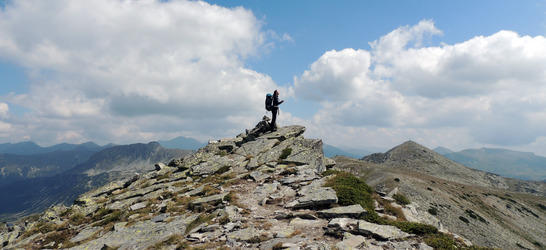
At the Freie Universität Berlin (Since Oct. 2012)
- Tectonics of Sedimentary Basins (MSc)
- Introduction to Plate Kinematics & GPlates Shortcourse (MSc)
- Seminar for current research (MSc)
- Introduction to field mapping (BSc)
- Field work in the Rheinisches Schiefergebirge, the Erzgebirge, the Armorican Massif and Corsica (BSc and MSc)
At the University of Rennes 1 (2008-2012)
- Tectonics (MSc of Earth Sciences)
- Structural Geology (BSc of Life and Earth Sciences)
- Magmatism and Volcanology (BSc of Mechanics, Physics and Chemistry)
- Mapping techniques (BSc of Earth Sciences)
- Geochemistry of stable isotopes (MSc of Earth Sciences)
- Magmatic Petrology (Bachelor of Geology)
- Field work in structural geology, tectonic, metamorphism and geomorphology in the Armorican Massif, the Pyrenees and the Montagne Noire (BSc and MSc of Earth Sciences)
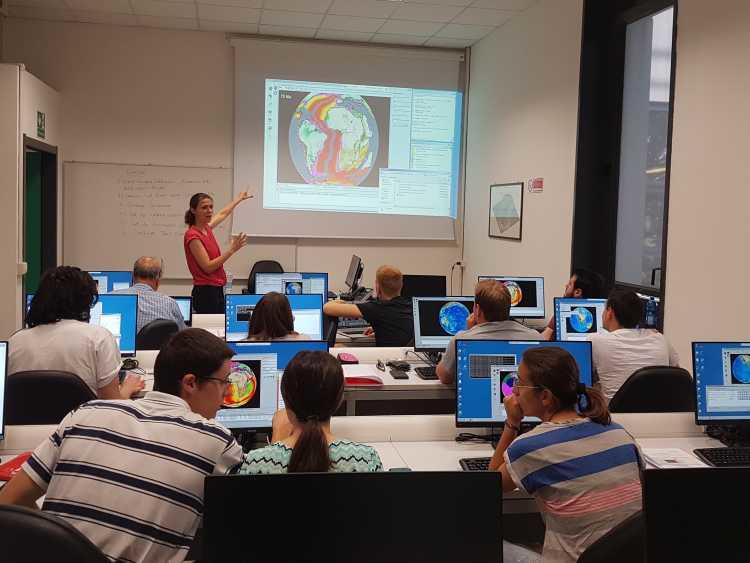
GPlates short course at the University of Parma, Italy, in the framework of an ERASMUS+ Mobility Agreement in June 2019 (Picture: Jessica Ecke)
My main research interest is to better understand the processes that link the motions and deformation of the mantle, the crust and the surface during lithospheric orogenesis and extension. I am particularly interested in the tectonic and sedimentary responses to deep-seated processes such as slab rollback, break-off and mantle flow.
My approach is to quantify the amount, direction and timing of plate motion and of tectonic deformation affecting the crust and basins to identify the driving forces and assess the characteristic timescales and magnitudes of the processes involved. This involves working on different temporal (Ma – 100s Ma) and spatial (outcrop to plate tectonics) scales and integrating various disciplines of the Earth Sciences, especially field geology, geochronology, geophysics (seismic data) and geodynamic modelling.
RESEARCH INTERESTS
- Plate tectonics, geodynamics, structural geology
- Plate kinematic reconstructions (using GPlates)
- Structural evolution of sedimentary basins and orogenic belts
- Extension in convergent tectonic settings
Studied areas: Alpine-Mediterranean belts and margins, NW Colombia, NE Atlantic and NW European Continental Margin
CURRENT PROJECTS
- AlpArray European Initiative – German Priority Program “Mountain Building in 4D” (SPP 4DMB):
- Linking surface kinematics to deep structure of the Adriatic indenter near a potential subduction-polarity switch, the Giudicarie Belt (Southern Alps)
Project in collaboration with Mark Handy (FU Berlin), Christian Haberland (GFZ), Michael Weber (GFZ), PhDs of Vincent Verwater (FU Berlin) and Azam Jozi-Najafabadi (GFZ Potsdam)
Student: Richard Sanders
Publications: Verwater et al., 2021, Jozi-Najafabadi et al. 2021 and Jozi-Najafabadi et al. 2022
- Switching pro- and retro-wedges in the Eastern Alps and their peripheral basins -> Hyperlink to Webpage: https://www.geo.fu-berlin.de/en/geol/fachrichtungen/geologie/sedimentary-systems/inhalt-elemente-sedi/project_description/project_retrowedges.html
Project in collaboration with Mark Handy, Anne Bernhardt, Peter MacPhee, PhD of Arthur Borzi (FU Berlin)
- Linking the deep structure to surface deformation: Body wave tomography of the Ligurian Sea and South-Western Alps
Project in collaboration with Dietrich Lange, Anke Dannowski and Heidrun Kopp, PhD of Louisa Murray-Bergquist (GEOMAR Kiel)
Student: Alex Jensen
- From plate tectonic reconstructions to 4D geodynamic models of the Alpine Orogeny
Project in collaboration with Boris Kaus, PhD of Christian Schuler (JGU Mainz)
Student: Javad Kasravi
Communication: Kaus et al. 2020, Keynote at EGU 2020
- AdriaArray European Initiative (https://www.ig.cas.cz/en/adriaarray-installation-of-broadband-stations/):
- Slab configuration beneath the Hellenides by combined teleseismic and local earthquake P-wave tomography – Implications for subduction dynamics, plate motion and deformation
Project in collaboration with Wolfgang Friederich (Bochum) and Jan Pleuger (FU Berlin)
Student: Olga Brunsmann
PAST PROJECTS
- New kinematic reconstructions of the Adriatic Plate as a key to understanding subduction processes in the Western Mediterranean (KAPMED)
DFG-funded project in collaboration with Mark Handy (FU Berlin) and Kamil Ustaszewski (Jena University)
Our study reveals that the Adriatic plate had an independent motion relative to Africa only recently in Neogene time and of limited amount. This divergence between Adria and Africa was accommodated by rifting along the Sicily Channel, while Adria rotated counter-clockwise of 5 ± 3° relative to Europe (Le Breton et al. 2017; Figure 1). Further back in time, Adria was connected to Africa and deformed internally along sinistral strike-slip faults accommodating Africa-Europe convergence.
Our kinematic reconstructions of the Alpine-Mediterranean area, implemented into a global plate circuit (Müller et al. 2019), complemented by thermo-mechanical modelling, shed new light on the past extent and opening kinematics of the Piemont-Liguria Ocean (Le Breton et al. 2021). The opening of the Central Atlantic in Jurassic times led to divergence between Europe and Africa and the opening of the Piemont-Liguria Ocean in four stages (stretching and thinning of the continental margin between 200-180 Ma and 180-165 Ma, respectively; mantle exhumation along OCT zones between 165- 154 Ma; oceanic spreading between 154-145 Ma). Spreading was slow to ultra-slow (up to 22 mm/yr), and ceased progressively in Early Cretaceous (145-130 Ma). This led to the formation of a small oceanic domain of maximum 250 km width. The opening of the North Atlantic at 145 Ma led to a period of mostly strike-slip tectonics along this domain. South-directed “alpine” subduction of the PL Ocean initiated at about 84 Ma, at rates of c. 8.6 mm/yr, and progressed from SE to NW till collision of the Adriatic plate with the European proximal margin at about 35 Ma. We highlight that at least 63 % of the subducted lithosphere was highly thinned continental lithosphere and most of Alpine Tethys Ophiolites came from OCT zones, which emphasizes the importance of the distal domain of continental margins in subduction and exhumation processes.
In Neogene time, plate convergence exceeded crustal shortening in all orogens surrounding Adria. We attribute this difference to tectonic erosion and crust-mantle decoupling of the Adriatic lithosphere. The results of this project provide new insights on the geodynamic evolution of the complex Alpine- Mediterranean area back to Mesozoic time and crucial quantitative constraints for geodynamic modelling of the Alpine Orogeny in 4D which may lead to a better interpretation of seismic tomography models beneath the Alps (DFG SPP 4DMB)
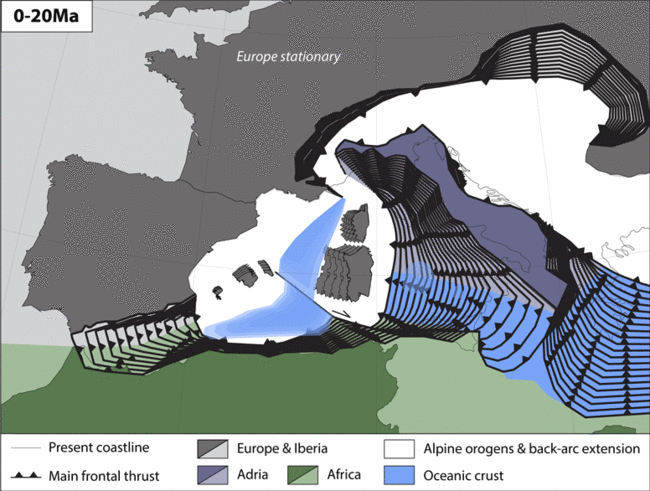
Figure 1: Map-view reconstruction of the motion of tectonic plates and frontal thrusts in the Western Mediterranean since 20 Ma (Le Breton et al. 2017).
Youtube Video: https://youtu.be/HdCzqbrv3cg
Plate tectonic reconstruction with continental deformation – Mediterranean view (Müller et al. 2019)
- NW Colombia – Formation and evolution of the San Jacinto fold belt and Lower Magdalena Valley basin
PhD of Alejandro Mora (Hocol S.A. Bogotá and GFZ Potsdam)
This project studies the link between forearc basin formation and evolution (detailed tectonostratigraphic analyses of the San Jacinto fold belt and Lower Magdalena Valley Basin in NW Colombia) and specific subduction/collision stages between the Caribbean and South American plates.
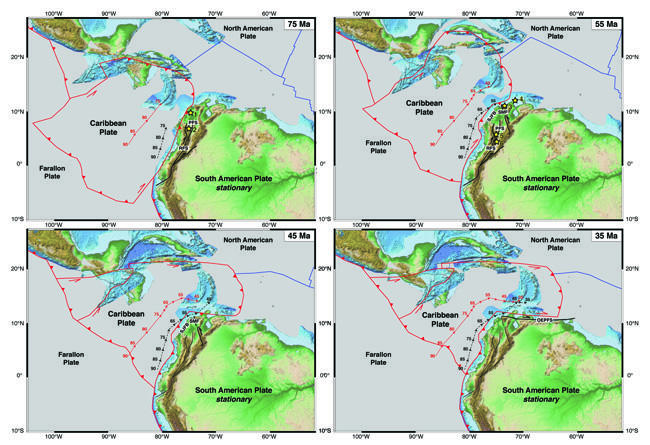
Figure 2: Paleotectonic reconstructions at 75, 55, 45, and 35 Ma, illustrating the displacement of the Caribbean Plate relative to fixed South America and the major change in convergence obliquity, which occurred between 55 and 45 Ma (see Mora et al. 2017).
- Differential spreading along the NE Atlantic Ocean and post-breakup deformation of the NW European Margin
During my PhD, I investigated how compressional deformation of the NW European Margin may have resulted from variations in the direction and rate of sea-floor spreading along the various ridges of the NE Atlantic. It involved a new kinematic reconstruction of the complex spreading history of the NE Atlantic and structural analyses along the NW European Margin (Le Breton et al., 2012) and along the Great Glen Fault in Scotland (Le Breton et al., 2013). I discussed in the PhD thesis the effect of mantle plumes (Tristan da Cunha and Iceland) on rifting and spreading processes in the South and NE Atlantic, respectively (see Le Breton 2012).
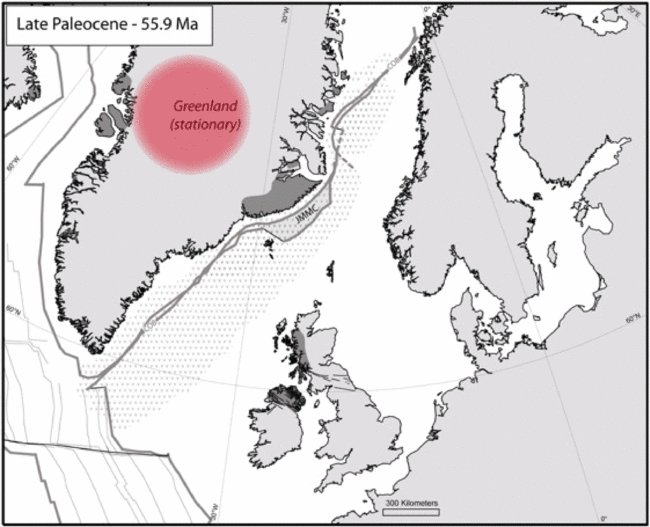
Figure 3: Map-view reconstruction of the opening of the NE Atlantic, formation of the Jan Mayen Microcontinent (JMMC) and post-breakup deformation along the NW European Continental (in red), red circle represents location of Iceland Mantle Plume head (see Le Breton et al. 2012).
- Post-glacial rebound of Iceland during Holocene time
During my MSc, I studied the combined effects of a ridge and a hotspot on surface deformation processes in Iceland. I mapped paleo-shorelines all around Iceland using digital elevations models, field data and a review of previous studies in order to quantify Holocene vertical displacements of the whole island, with a focus on the post-glacial rebound following the Weichselian glaciation and I discussed its spatial variations in terms of ice unloading and rheology (Le Breton et al., 2010).
2023
Jozi Najafabadi, A., Haberland, C., Handy, M.R., Le Breton, E. and Weber, M. (2023). Seismic wave attenuation (1/Qp) in the crust underneath the Eastern and eastern Southern Alps (Europe): imaging effects of faults, fractures, and fluids. Earth, Planet and Space, 75:187, https://doi.org/10.1186/s40623-023-01942-0
Maiorana, M., Artoni, A., Le Breton, E., Sulli, A., Chizzini, N., Torelli, L. (2023). Is the Sicily Channel a simple Rifting Zone? New evidence from seismic analysis with geodynamic implications. Tectonophysics, Vol. 864, 230019, https://doi.org/10.1016/j.tecto.2023.230019.
Gonzalez, R., Oncken, O., Faccenna, C., Le Breton, E., Bezada, M., & Mora, A. (2023). Kinematics and convergent tectonics of the Northwestern South American plate during the Cenozoic. Geochemistry, Geophysics, Geosystems, 24, e2022GC010827, https://doi.org/10.1029/2022GC010827.
Belayouni, H., Guerrera, F., Martin-Martin, M., Le Breton, E., and Tramontana, M. (2023). The Numidian formation and its Lateral Successions (Central-Western Mediterranean): a review, International Geology Review, https://doi.org/10.1080/00206814.2023.2199429
Martin-Martin, M., Guerrera, F., Cañaveras, J.C., Alcalá, F.J., Serrano, F., Maaté, A., Hlila, R., Maaté, S., Tramontana, M., Sánchez-Navas, A., Le Breton, E. (2023). Paleogene evolution of the External Rif Zone (Morocco) and comparison with other western Tethyan margins. Sedimentary Geology, 448, 106367. https://doi.org/10.1016/j.sedgeo.2023.106367
2022
Jozi Najafabadi, A., Haberland, C., Le Breton, E., Handy, M. R., V.F. Verwater, B. Heit, M. Weber, and the AlpArray, AlpArray SWATH-D working group. Constraints on crustal structure in the vicinity of the Adriatic Indenter (European Alps) from Vp and Vp/Vs Local Earthquake Tomography, Journal of Geophysical Research, https://doi.org/10.1029/2021JB023160
2021
Verwater, V. F., Le Breton, E., Handy, M. R., Picotti, V., Jozi Najafabadi, A., and Haberland, C.: Neogene kinematics of the Giudicarie Belt and eastern Southern Alpine orogenic front (Northern Italy), Solid Earth,12, 1309–1334, https://doi.org/10.5194/se-12-1309-2021
Jozi Najafabadi, A., Haberland, C., Ryberg, T., Verwater, V. F., Le Breton, E., Handy, M. R., Weber, M., and the AlpArray and AlpArray SWATH-D working groups: Relocation of earthquakes in the southern and eastern Alps (Austria, Italy) recorded by the dense, temporary SWATH-D network using a Markov chain Monte Carlo inversion, Solid Earth, 12, 1087–1109, PDF.
Le Breton, E., Brune, S., Ustaszewski, K., Zahirovic, S., Seton, M., and Müller, R. D.: Kinematics and extent of the Piemont–Liguria Basin – implications for subduction processes in the Alps, Solid Earth, 12, 885–913, PDF.
Gomez-Garcia A. M., E. Le Breton, M. Scheck-Wenderoth, G. Monsalve, D. Anikiev. The preserved plume of the Caribbean Large Igneous Plateau revealed by 3D data-integrative models. Solid Earth, 12, 275–298, PDF.
2020
Mora–Bohórquez, J.A., Oncken, O., Le Breton, E., Ibañez–Mejia, M., Veloza, G., Mora, A., Vélez, V. & De Freitas, M. 2020. Formation and evolution of the Lower Magdalena Valley Basin and San Jacinto fold belt of northwestern Colombia: Insights from Upper Cretaceous to recent tectono–stratigraphy. In: Gómez, J. & Mateus–Zabala, D. (editors), The Geology of Colombia, Volume 3 Paleogene – Neogene. Servicio Geológico Colombiano, Publicaciones Geológicas Especiales 37, p. 21–66. Bogotá. https://doi.org/10.32685/pub.esp.37.2019.02
2019
Müller R.D., S. Zahirovic, S.E. Williams, J. Cannon, M. Seton, D.J. Bower, M.G. Tetley, C. Heine, E. Le Breton, S. Liu, S.H.J. Russel, T. Yang, J. Leonard and M. Gurnis, 2019. A global plate model including lithospheric deformation along major rifts and orogens since the Triassic. Tectonics, 38. https://doi.org/10.1029/2018TC005462. PDF
2018
Mora J.A., O. Oncken, E. Le Breton, A. Mora, G. Veloza, V. Vélez, M. de Freitas (2018). Controls on forearc basin formation and evolution: Insights from Oligocene to Recent tectono-stratigraphy of the Lower Magdalena Valley basin of northwest Colombia, Marine and Petroleum Geology, 97, 288-310, doi.10.1016/j.marpetgeo.2018.06.032. PDF
2017
Le Breton E., M.R. Handy, G. Molli and K. Ustaszewski (2017). Post-20 Ma motion of the Adriatic plate – new constrains from surroundingorogens and implications for crust-mantle decoupling,Tectonics, doi:10.1002/2016TC004443. PDF
Mora, J.A., O. Oncken, E. Le Breton, M. Ibánez-Mejia, C. Faccenna, G. Veloza, V. Vélez, M. de Freitas and A. Mesa (2017).Linking Late Cretaceous to Eocene Tectono-stratigraphy of the San Jacinto fold belt of NW Colombia with Caribbean plateau collision and flat subduction, Tectonics, 36, doi:10.1002/2017TC004612. PDF
2013
Le Breton E., Cobbold, P.R., Zanella, A.,2013. Cenozoic reactivation of the Great Glen Fault, Scotland: Additional Evidence and Possible Causes. Journal of the Geological Society, London, Vol. 170, pp. 403-415.doi: 10.1144/jgs2012-067. PDF
2012
Le Breton E., Cobbold, P.R., Dauteuil O. and Lewis G., 2012. Variation in amount and direction of sea-floor spreading along the North East Atlantic Ocean and resulting deformation of the continental margin of North West Europe. Tectonics, 31, TC5006, doi:10.1029/2011TC003087. PDF
Auxiliary material for this paper (please cite the paper above when using these data):
- Geographic coordinates of NE Atlantic isochrones and fractures zones PDF
- Plots of restoration of the opening of the NE Atlantic for 13 stages for each restoration, calculation of the G values for the restorations, and tables of the best fit rotation poles and their uncertainties for each spreading system for both models PDF
2010
Le Breton E., Dauteuil O., Biessy G., 2010. Postglacial rebound of Iceland during the Holocene. Journal of the Geological Society, London, Vol 164, pp. 417-432. doi : 10.1144/0016-76492008-126. PDF

